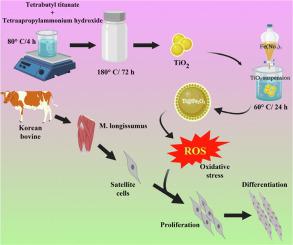Bioorganic Chemistry ( IF 4.5 ) Pub Date : 2020-11-06 , DOI: 10.1016/j.bioorg.2020.104459 Vaikundamoorthy Ramalingam , Mohan Harshavardhan , Inho Hwang

|
In the present study, the titanium decorated iron oxide (Ti@Fe2O3) nanocomposites are synthesized using the chemical method. The as-prepared nanocomposite was characterized for successful formulation and the elemental spectra showed the composition of Fe (44%), Ti (0.71%) and O (55%) is confirmed the homogenous distribution. Crystallographic spectra depict the strong peaks corresponding to the of TiO2 and Fe2O3 nanoparticles planes with minor shift variation due to the formulation of Ti on the surface of Fe2O3 nanoparticles and it is also confirmed with SAED analysis. The X-ray photoelectron spectroscopy (XPS) analysis of Ti@Fe2O3) nanocomposite confirms the existence of elements such as Fe, O and Ti. Further, the morphology of the composite showed the well-defined encapsulation and aggregation of TiO2 nanoparticles on the surface of Fe2O3 nanoparticles. Further, the TiO2 nanoparticles showed less cytotoxic activity against bovine satellite cells, as well the nanocomposite increased the growth of bovine satellite cells comparing with control cells. Further, the morphological analysis showed the significant changes in TiO2 nanoparticles treated cells and the nanocomposite induces the myotube formation due to the increased ROS level in bovine satellite cells. Moreover, the nanocomposite regulates the expression of genes IGF-1, TGF-β, MSTN, CASP3, CASP2 and proteins such as CALP1, CALP2, MyoD, MyoG which are responsible for the growth, proliferation, and differentiation of satellite cells. Together, the prepared Ti@Fe2O3 nanocomposites afford additional support for the applications of nanomaterials in skeletal muscle repair and tissue regeneration engineering.
中文翻译:

钛装饰的氧化铁(Ti @ Fe2O3)通过氧化应激调节牛肌肉卫星细胞的增殖
在本研究中,使用化学方法合成了钛装饰的氧化铁(Ti @ Fe 2 O 3)纳米复合材料。对所制备的纳米复合材料进行了表征,可以成功配制,并且元素光谱表明,Fe(44%),Ti(0.71%)和O(55%)的组成得到了均匀分布。晶体光谱描绘对应于TiO 2的强峰2和Fe 2 ö 3个纳米颗粒有轻微移变化平面由于钛的Fe的表面上的配制剂2 ö 3纳米颗粒,并且它也与SAED分析证实。Ti @ Fe 2 O的X射线光电子能谱(XPS)分析3)纳米复合材料证实了诸如Fe,O和Ti等元素的存在。此外,复合材料的形态显示出在Fe 2 O 3纳米颗粒表面上TiO 2纳米颗粒的明确包封和聚集。此外,TiO 2纳米颗粒对牛卫星细胞显示出较少的细胞毒活性,并且与对照细胞相比,纳米复合材料增加了牛卫星细胞的生长。此外,形态分析表明TiO 2的显着变化纳米颗粒处理的细胞和纳米复合材料可诱导肌管形成,这是由于牛卫星细胞中的ROS水平升高所致。此外,纳米复合物调节基因IGF-1,TGF-β,MSTN,CASP3,CASP2和诸如卫星细胞的生长,增殖和分化的CALP1,CALP2,MyoD,MyoG等蛋白质的表达。在一起,制备的Ti @ Fe 2 O 3纳米复合材料为纳米材料在骨骼肌修复和组织再生工程中的应用提供了额外的支持。











































 京公网安备 11010802027423号
京公网安备 11010802027423号